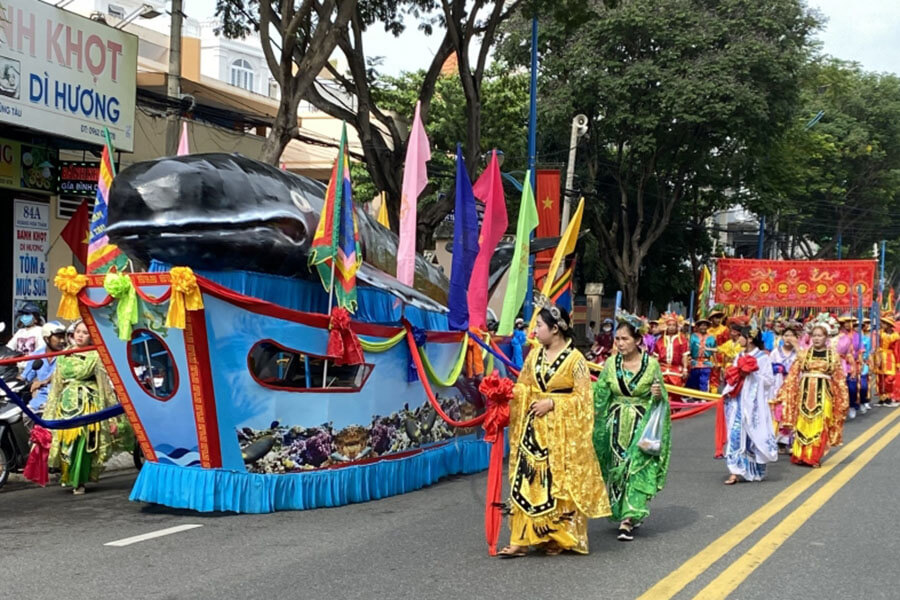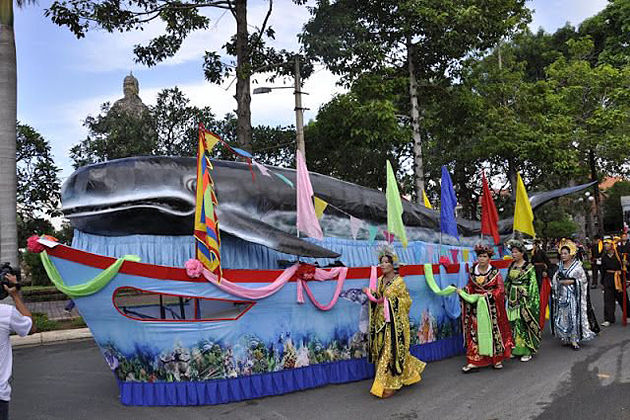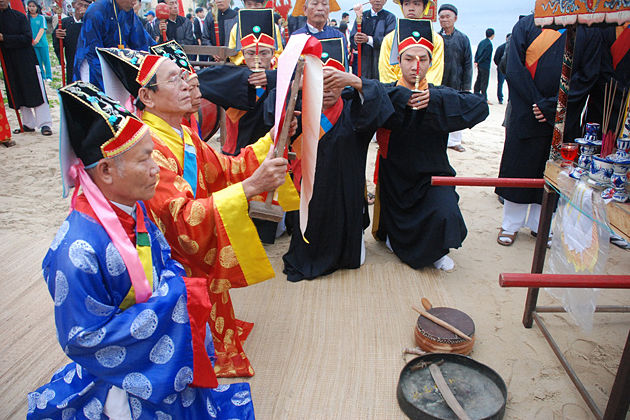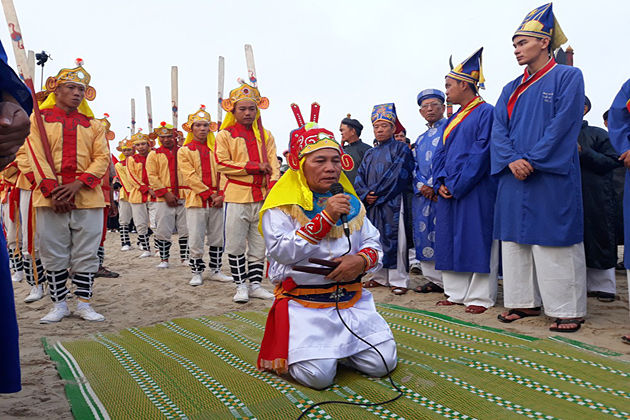Hoi Ruoc Ca Voi (Whale Festival) is the unique festival in Vietnam organized in Vam Lang Village (Go Cong District, Long An) which venerates a whale to which King Gia Long (1802-1820) conferred the title Nam Hai Đại Vương (Lord of the Southern Sea). The Whale festival is held at midnight on the 15th of the 6th lunar month. After monks say prayers, votive objects are burnt, and sweet cakes are distributed to the children. At 1:00 am, the village authorities, accompanied by women singers and an orchestra, board a sampan on which an altar with food offerings has been set up. They go from Vam Lang to the mouth of the Soi Rap River to celebrate the ceremony of welcoming the Lord. The boat sails back by the same route. Fishermen hang lanterns on their boats and people set up altars along the way. The boats arrive back at the temple amid shouting and the explosion of firecrackers. The incense burner is. put back in place while village leaders conclude the ceremony. According to Vam Lang villagers, if a real whale is observed spouting water during the festival, this is an auspicious omen for the village over the next year.
The Cult of Whale in Vietnam through Whale Festival
You can see all along the coast from the province of Thanh Hoa to the island of Phu Quoc, temples dedicated to whales. Fishermen will tell you that hurricanes push Venerable Dead Whales towards the shores so that men can perform funerals worthy of them. In fact discovering a dead whale, providing him with a funeral brings wealth to the community. At the time of kings, at the news of such an event, the court sent someone to present sufficient offerings to be able to make him a funeral of Great King of the South Sea.
The boats of Central Vietnam are also adorned with whale eyes, a sacred animal object of this pre-Viet cult practiced by the fishing communities. These marine mammals frequent the coast of the country, and even come, according to testimonies, to take refuge in the bays and the estuaries, sheltered from the typhoons during the bad season, which is also the one where the plankton and the krill abound whales. The boats of Central Vietnam are decorated with whale eyes, a sacred animal that is the subject of pre-war worship practiced by fishing communities.
500-Year Whale Cemetery
No other place except Vietnam has such a large whale cemetery. From time immemorial, when a whale is found dead by the inhabitants stranded on the shore, it is buried following a ritual ceremony worthy of a god. The whale cemetery is located in the fishing village of Thuan An, a coastal town of Tam Hai, Nui Thanh District, Quang Nam Province (Central). This cemetery was laid out on a vast piece of white sand, in the middle of a poplar forest populated near a beach.
The cemetery has exactly 529 aligned tombs, each of which features a stylized stone stele. Nobody knows exactly when the first whale was buried or when the first shrine was built. Seniors in the village of Thuan An say that this cemetery is about 500 years old. At the beginning of the 19th century, King Gia Long (who ruled from 1802 to 1820) crowned a whale stranded in Tam Hai. His tomb is in the heart of the site. This whale cemetery has been recognized as a historical and cultural heritage of Quang Nam province.
Legend & Reality of Whale Festival
Whales are among the largest animal species on the planet and are present in all the world’s oceans as they migrate. The difference is that in many coastal regions in Vietnam, they are considered as the embodiment of the genius of the sea. According to the popular concept of fishermen, the whale is a sacred sea creature and when it appears, it is often to help and save people at risk at sea.
The old fisherman Truong Van Dong, with more than 60 years of experience in offshore fishing, says that about ten years ago, his boat was caught in a typhoon on the high seas. By a miracle, a whale appeared and brought him and his crew back to the mainland. “Every time the fishermen in my village face a storm at sea, they pray that the whales help them get out of this bad situation. And this genius of the sea gives us strength when we go off, knowing he is watching over us, “he says.
It is possible to make some reservations about the veracity of these stories about whales that save the lives of fishermen. But what does it matter, since in any case these stories are transmitted from generation to generation in this region that lives entirely from fishing? In the spirit of the older fishermen, whales are, whatever happens, a legendary animal. That’s why every time one of these creatures is found stranded on Tam Hai Beach, the villagers organize funerals with ritual invocations. The corpse is impregnated with alcohol and placed in a coffin made of bamboo before being buried in the cemetery of the whales.
Whale Festival Dedicated to the Genius of the Sea
At each arrival of spring, the villagers of Tam Hai organize a ceremony of offerings at the whale cemetery to ask the occult forces and the genius of the sea good weather, calm sea and a good fishing season.
On the 20th day of the 1st lunar month, this ceremony, also called the feast of Nghinh Ong, is organized with great fanfare by fishermen. In the early morning, the elderly in the region, accompanied by thousands of fishermen, all on their thirty-one, perform at the cemetery a worship rite dedicated to whales. Then, a procession leaves to join the beach. On the sea, several rows of fishing boats, large and small, decorated with flags and multicolored flowers gather around a dragon boat on which organize rites of application for a good year of fishing.
The Nghinh Ong festival is steeped in the tradition of fishermen of this coastal region, who come to pray for the leniency of the weather, a successful fishing season and prosperity.




